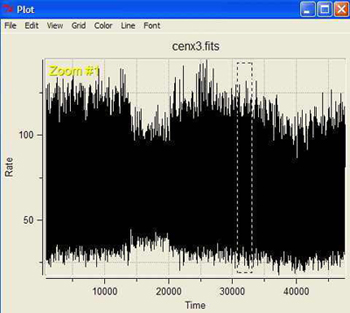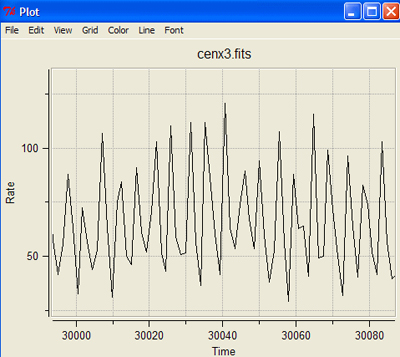Education Activities To Accompany Chandra Data Analysis Software
Cen X-3 & Clocks in the Sky
Fine tuning the light curve
Because the light variation is so rapid, let's zoom in on the data and see what's happening over a small time interval. Place your cursor near the base of the light curve, just above the tick mark at 30000, and left click. While holding down the button, drag the cursor upward and over into a skinny tall box about a quarter of an inch wide. (Note: it is NOT important exactly where you select the data from; you just want to isolate a small portion of the curve.) After you have selected your box, left click again.
A new light curve will appear that zooms in on the box you just selected. Repeat this procedure again, and after one or two more tries, you will have zoomed in on a portion of the curve where individual pulses can be easily seen (a horizontal range of about 100 seconds in time is good). By the way, If you make a mistake, or don't like the selection you made, or just want to try again, all you have to do is right click on the plot to go back to the previous graph.
Eventually your light curve should look something like the figure below.
You can now easily see the x-ray light from Cen X-3 varying up and down with time. What would you estimate the period of the variation to be? ("Period" is the time from one peak to the next peak. )
It looks like Cen X-3 is pulsing in brightness about every 5 seconds (or just under), right? The frequency of the light variation (the reciprocal of period) is therefore approximately 0.2 s-1 .
Making a rough estimate of the period of light variation is easy in this case (as long as you can see the individual peaks and troughs of brightness), but what if the period isn't very obvious?
And how can you determine the period in the most accurate way?
And what could be going on that could cause this source to vary in brightness so quickly, yet so regularly?
|



